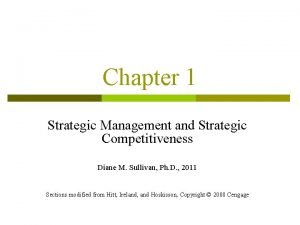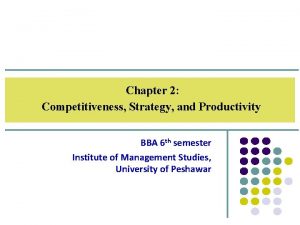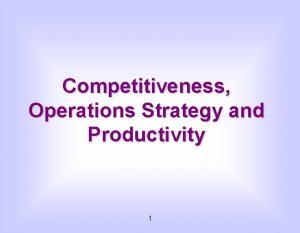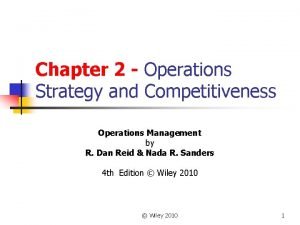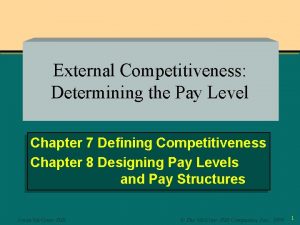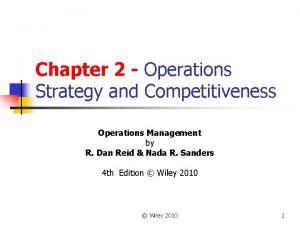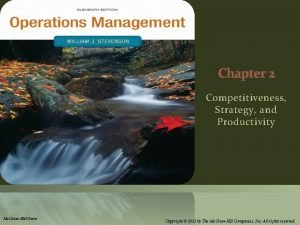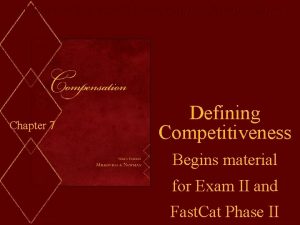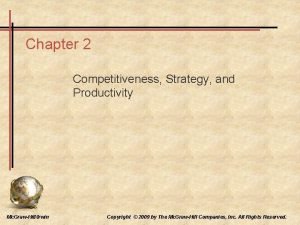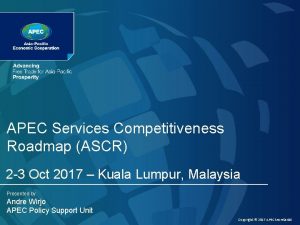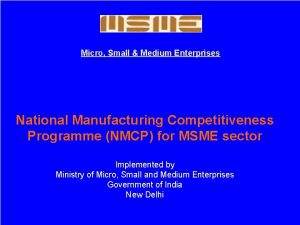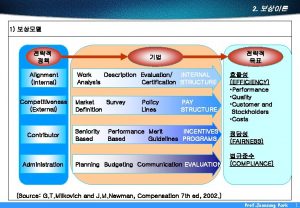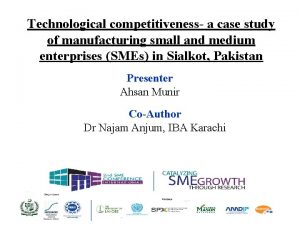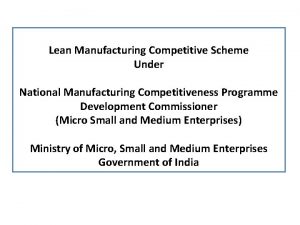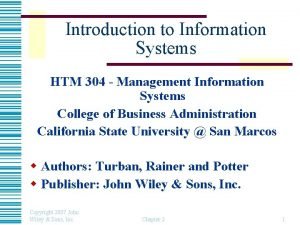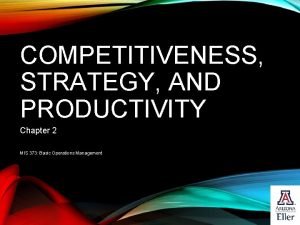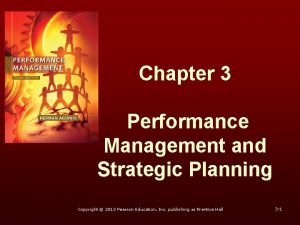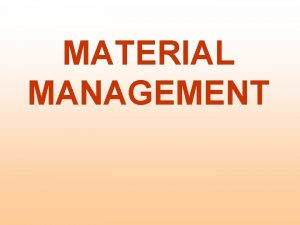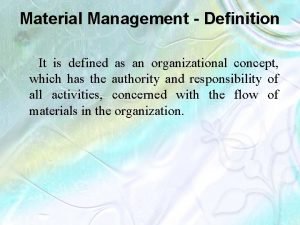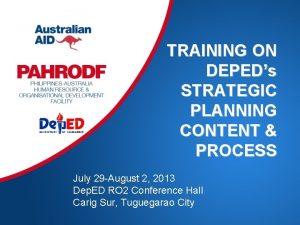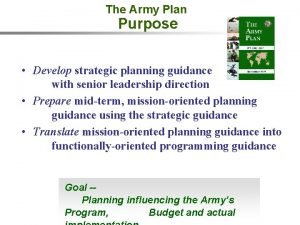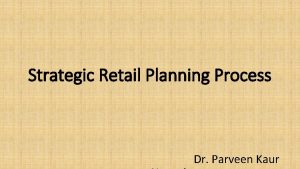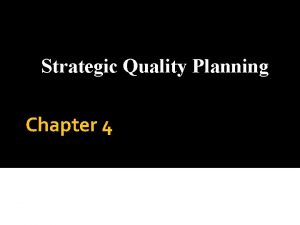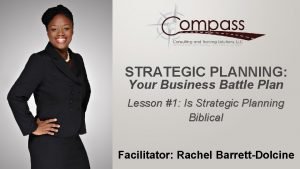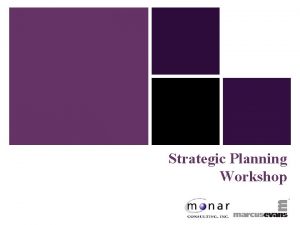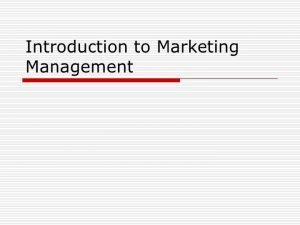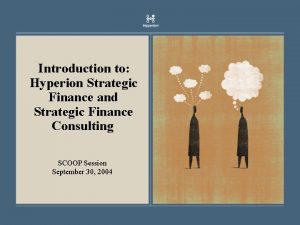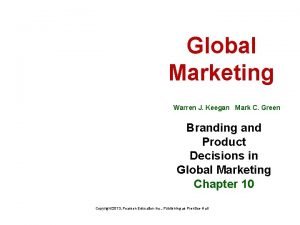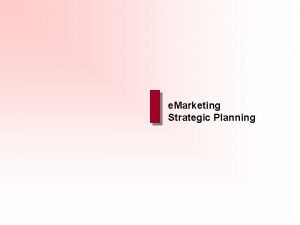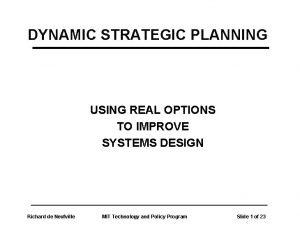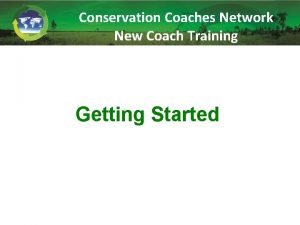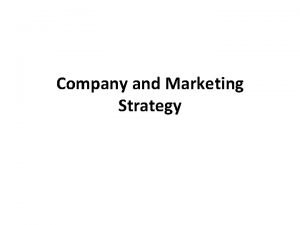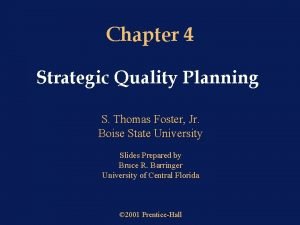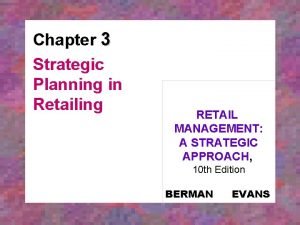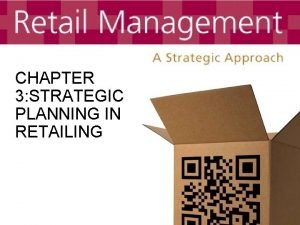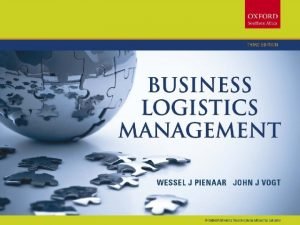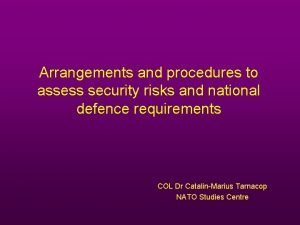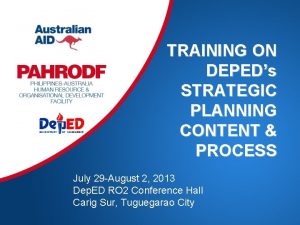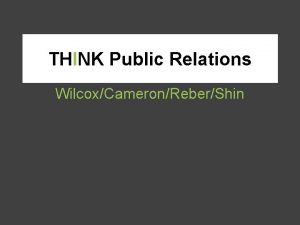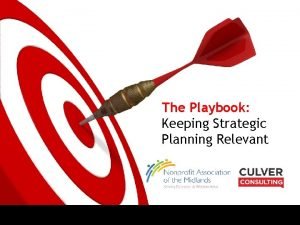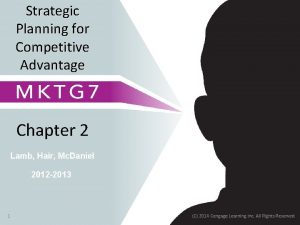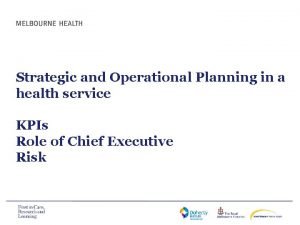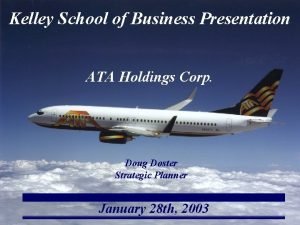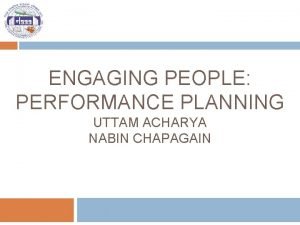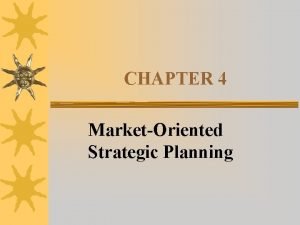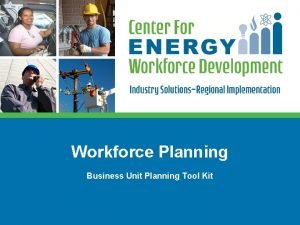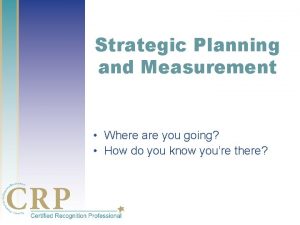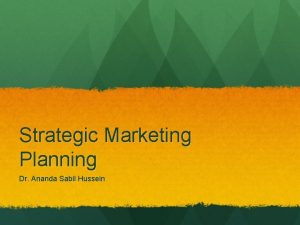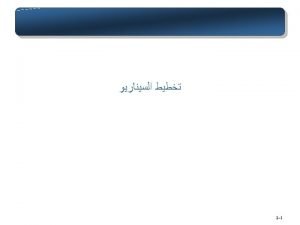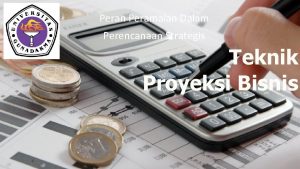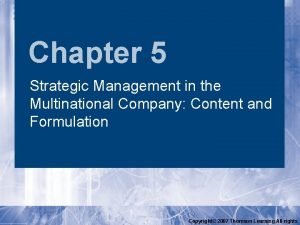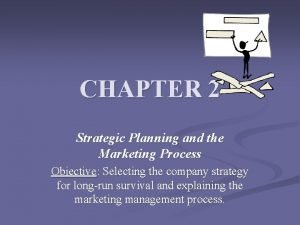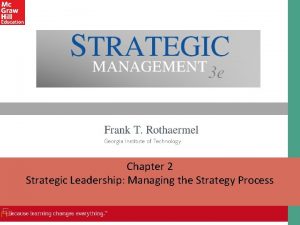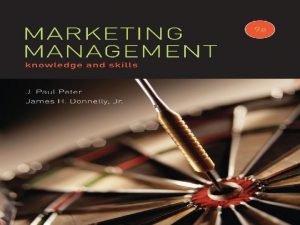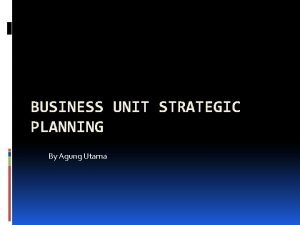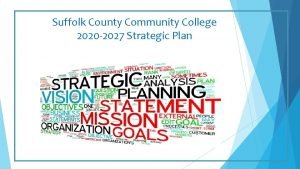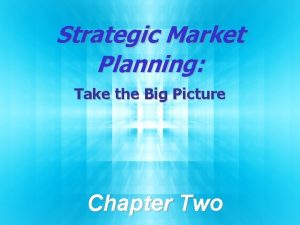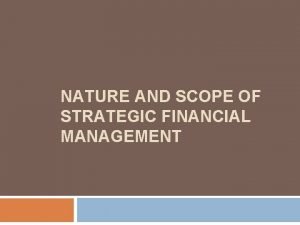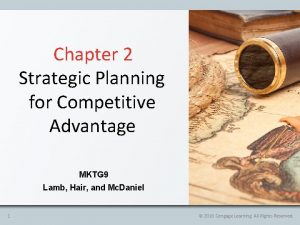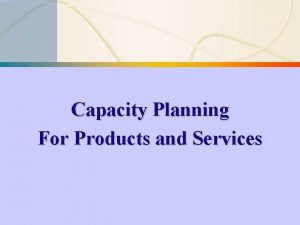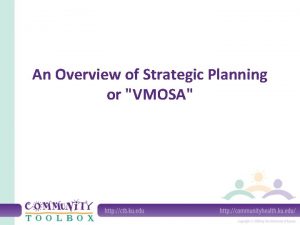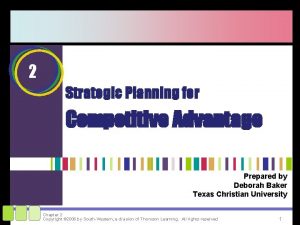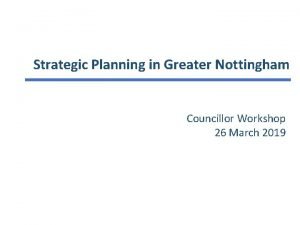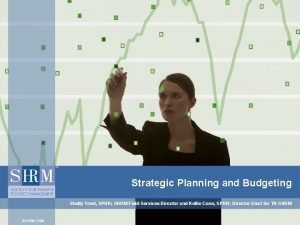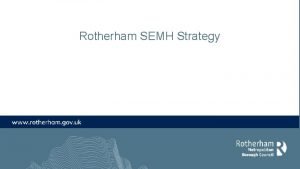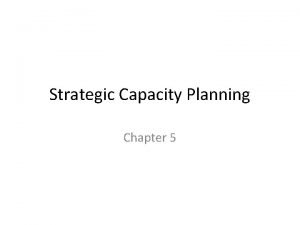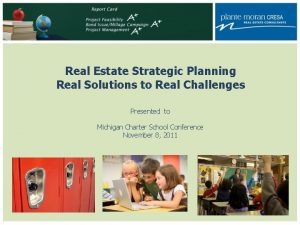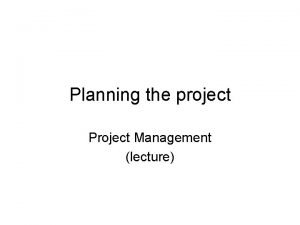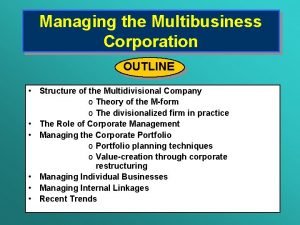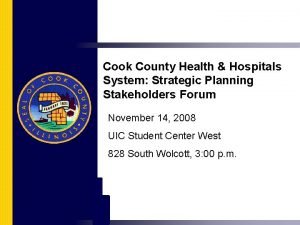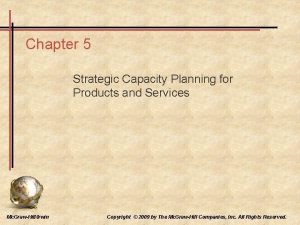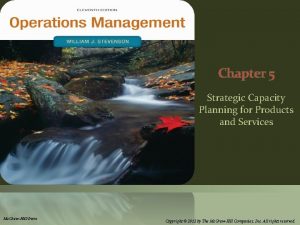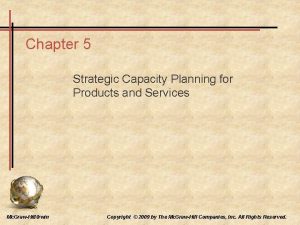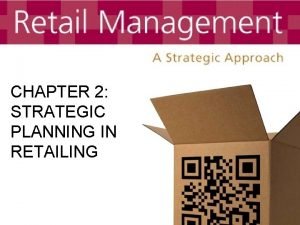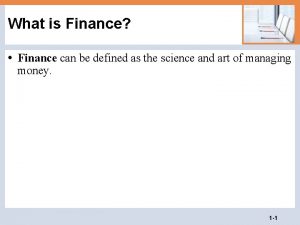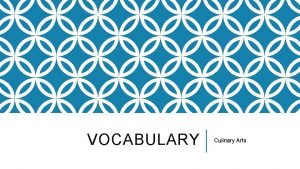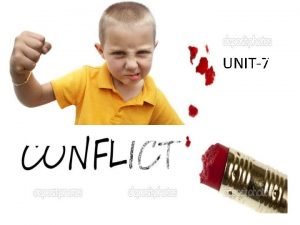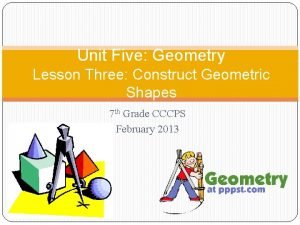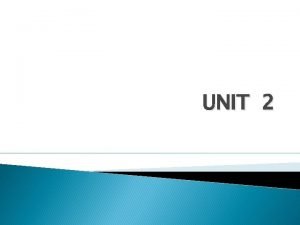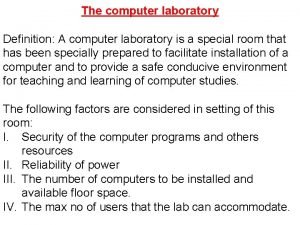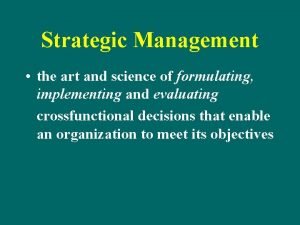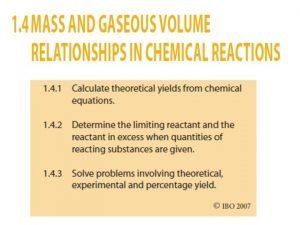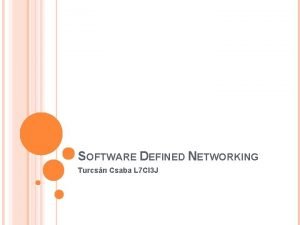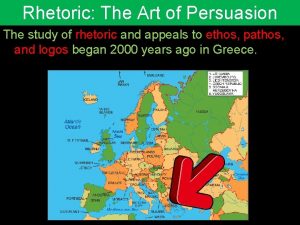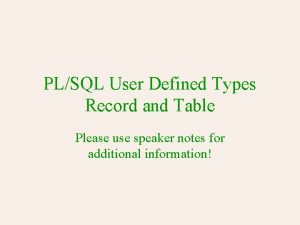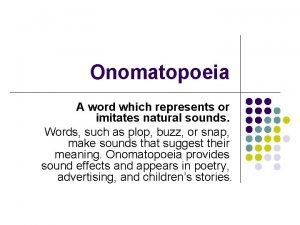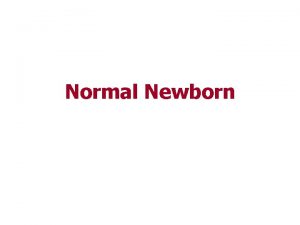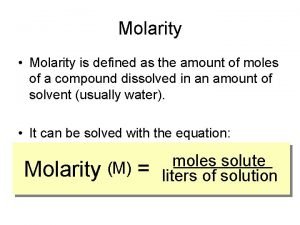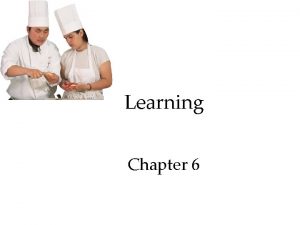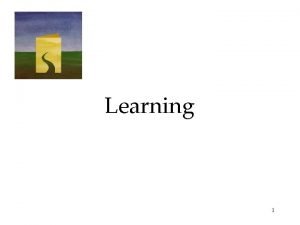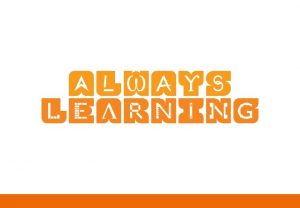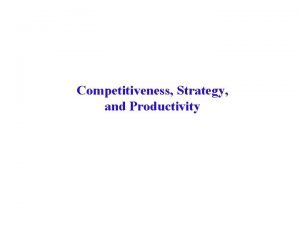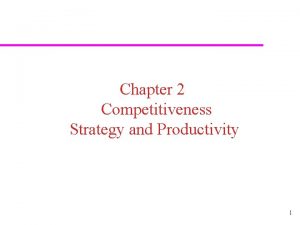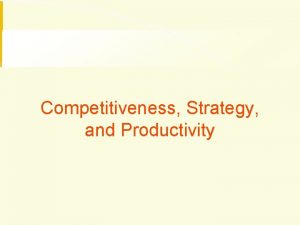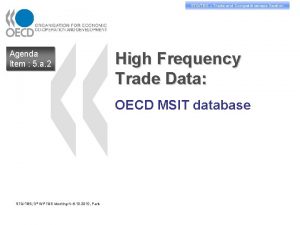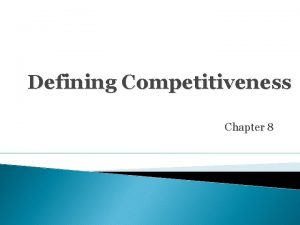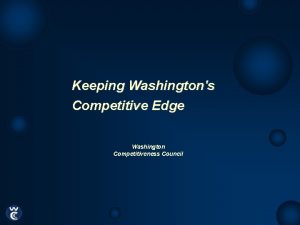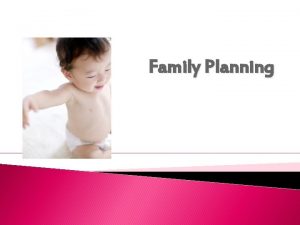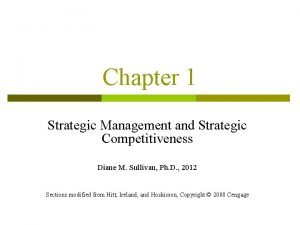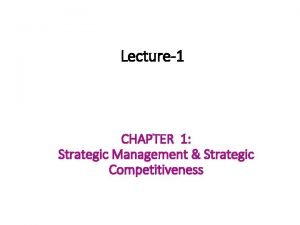Strategic Management Strategic Planning Competitiveness Strategic Management Defined
































































































































- Slides: 128

Strategic Management Strategic Planning& Competitiveness

Strategic Management – Defined Art & science of formulating, implementing, and evaluating, cross-functional decisions that enable an organization to achieve its objectives.

Adapting to Change – Key Strategic Management Questions • What kind of business should we become? • Are we in the right fields • Are there new competitors • What strategies should we pursue? • How are our customers changing?

Key Terms Vision Statement – What do we want to become? Mission Statement – What is our business?

Key Terms Opportunities & Threats (External) Analysis of Trends: • Economic • • Social Cultural Demographic/Environmental Political, Legal, Governmental • Technological • Competitors

Key Terms Strengths & Weaknesses (Internal) Typically located in functional areas of the firm • Management • • • Marketing Finance/Accounting Production/Operations Research & Development Computer Information Systems

Key Terms Strategies q. Means by which long-term objectives are achieved

What is Strategy? • An integrated and coordinated set of commitments & actions designed to exploit core competencies and gain a competitive advantage. • A series of goal direceted decisions & actions • Strategies is use of engagements for the object. © 2006 by Nelson, a division of Thomson 1 -8

What is Strategy in different literature? “A unified, comprehensive, and integrated plan designed to ensure that the basic objectives of the enterprise are achieved. ” (Glueck, 1980: 9) “The pattern or plan that integrates an organization’s major goals, policies, and action sequences into a cohesive whole. ” (Quinn, 1980) “A pattern of resource allocation that enables firms to maintain or improve their performance. “A good strategy… neutralizes threats and exploits opportunities while capitalizing on strengths and avoiding or fixing weaknesses. ” (Barney, 1997: 17) © 2006 by Nelson, a division of Thomson 1 -9

• All successful strategies are based on understanding of the organization’s competitive environment. • The competitive environment is complex, and includes anything that can affect the organization’s position relative to that of its competitors. • Competitive enviroment is related with organizations’ products, services and organizational resources. © 2006 by Nelson, a division of Thomson 1 -10

Why Strategy is important? • • • To change on organizations needs Burning platform Vision Leadership Strategic management Political management © 2006 by Nelson, a division of Thomson 1 -11

Strategy Formulation Vision & Mission External Opportunities & Threats Internal Strengths & Weaknesses Long-Term Objectives Alternative Strategies Strategy Selection

Strategic Manegement involves; • Organization goals • Goal- oriened action • Related decision and actions • Internal strengts • External oppotunities and threats © 2006 by Nelson, a division of Thomson 1 -13

Strategic manegement Makes; • Planning • Organization • Implementing • Controlling © 2006 by Nelson, a division of Thomson 1 -14

Why is SM important? • Given everyone a role • Makes a difference in performance levels • Provides systematic approach to uncertainities • Coordinates & focuses employess © 2006 by Nelson, a division of Thomson 1 -15

Basic of Strategic Manegement There are four aspects are too important; • Interdisciplinary • External focus competition • Internal factors • Future direction And make: Situation analysis (analsis current situation) Formulation of strategies (decision strategies) Implementation of Strategies (putting strategies in action) by Nelson, a division of Thomson 1 -16 Evaluation© 2006 of strategies( evaluating & changing)

The Strategic Management Process The full set of commitments, decisions, and actions required for a firm to achieve strategic competitiveness and earn above-average returns. © 2006 by Nelson, a division of Thomson 1 -18

Strategic Management and Strategic Competitiveness Knowledge objectives 1. 2. 3. 4. Define strategic competitiveness, competitive advantage and above average returns. Describe the 21 st century competitive landscape and explain how globalization and technological changes shape it. Use the industrial organization (I/O) model to explain how firms can earn above average returns. Use the resource-based model to explain how firms can earn above-average returns. © 2006 by Nelson, a division of Thomson 1 -19

Strategic Management and Strategic Competitiveness Knowledge objectives – continued… 5. 6. 7. 8. Describe strategic intent and strategic mission and discuss their value. Define stakeholders and describe their ability to influence organizations. Describe strategists’ work. Explain the strategic management process. © 2006 by Nelson, a division of Thomson 1 -20

Achieving Sustained Competitive Advantage 1. Adapting to change in external trends, internal capabilities and resources 2. Effectively formulating, implementing & evaluating strategies

Comprehensive strategic management model External Audit Vision & Mission Long-Term Objectives Internal Audit Generate, Evaluate, Select Strategies Implement Strategies: Mgmt Issues Implement Strategies: Marketing, Fin/Acct, R&D, CIS Measure & Evaluate Performance

Strategy Implementation Annual Objectives Policies Employee Motivation Resource Allocation

Strategy Evaluation Internal Review External Review Performance Metrics Corrective Actions

Desired Strategic Outcomes Strategic Competitiveness Achieved when a firm successfully formulates and implements a value-creating strategy. Sustained Competitive Advantage Occurs when a firm develops a strategy that competitors are not simultaneously implementing. Provides benefits which current and potential competitors are unable to duplicate. Above-Average Returns in excess of what an investor expects to earn from other investments with similar risk. © 2006 by Nelson, a division of Thomson 1 -25

Important definitions Risk An investor’s uncertainty about the economic gains or losses resulting from a particular investment. Average returns Returns equal to what an investor expects from other investments with similar amount of risk. Strategic management process The full set of committee's decisions and actions required for a firm to achieve strategic competitiveness and earn above average returns. © 2006 by Nelson, a division of Thomson 1 -26

Intended, Emergent and Realized Strategies © 2006 by Nelson, a division of Thomson 1 -27

Alternative Models of Superior Returns Industrial Organization Model O I Resource. Based Model The External Environment Resources An Attractive Industry Capabilities Strategy Formulation Competitive Advantage Assets and Skills An Attractive Industry Strategy Implementation Superior Returns © 2006 by Nelson, a division of Thomson 1 -28

Valuable Rare Costly to imitate Organized to be exploited Resources and Capabilities Four Attributes of Resources and Capabilities (Competitive Advantage) Allow the firm to exploit opportunities or neutralize threats in its external environment. Possessed by few, if any, current and potential competitors. When other firms cannot obtain them or must obtain them at a much higher cost. The firm is organized appropriately to obtain the full benefits of the resources in order to realize a competitive advantage. © 2006 by Nelson, a division of Thomson 1 -29

Resources and capabilities that meet these four criteria become a source of: Rare Costly to imitate Organized to be exploited Resources and Capabilities Valuable Core Competencies © 2006 by Nelson, a division of Thomson 1 -30

Core Competencies are the basis for a firm’s Competitive advantage Strategic competitiveness Core Competencies Ability to earn above-average returns © 2006 by Nelson, a division of Thomson 1 -31

CEO’s ranking of business importance 1. A strong & well thought out strategy 2. Maximizing customer satisfaction & loyalty 3. Business leadership, quality products & services 4. Concern for consistent profits 5. Strong & consistent profits © 2006 by Nelson, a division of Thomson 1 -32

st 21 Century Values • Flexibility • Speed to market • Innovation • Integration • Handling challenges from constantly changing conditions • Hypercompetition © 2006 by Nelson, a division of Thomson 1 -33

The Global Economy One in which goods, services, people, skills, and ideas move freely across geographic borders © 2006 by Nelson, a division of Thomson 1 -34

World competitiveness ratings © 2006 by Nelson, a division of Thomson 1 -35

Technology and Technological Change • Increasing rate of technological change and diffusion Perpetual innovation • The information age Personal computers, cellular phones, artificial intelligence, virtual reality, massive databases, electronic networks, e-business • Increasing knowledge intensity Information, intelligence, expertise, strategic flexibility. © 2006 by Nelson, a division of Thomson 1 -36

Strategic Intent Internally focused, it is the leveraging of a firms resources, capabilities, and core competencies to establish the firms goals in the competitive environment. Strategic Mission Externally focused, it is a statement of a firms unique purpose and the scope of it’s operations in product and market terms. Together, strategic intent and strategic mission yield the insights required to formulate and implement strategies. © 2006 by Nelson, a division of Thomson 1 -37

Stakeholders © 2006 by Nelson, a division of Thomson 1 -38

Organizational strategists Top level managers, executives, top management team, or general managers © 2006 by Nelson, a division of Thomson 1 -39

Organizational culture A complex set of ideologies, symbols and core values that influence how the firm conducts it’s business. © 2006 by Nelson, a division of Thomson 1 -40

Predicting Outcomes of Strategic Decisions 1. 2. 3. 4. Define the profit pool’s boundaries. Estimate the pool’s overall size. Estimate the size of the value chain. Reconcile the calculations. The strategic management process calls for disciplined approaches to the development of competitive advantage. © 2006 by Nelson, a division of Thomson 1 -41

Game Theory Notes by Prof. Richard B. Goldstein

Glossary • • Payoff/Reward Matrix Two Person Game Zero-sum Column domination Row domination Saddle/Equilibrium Point Strategies © 2006 by Nelson, a division of Thomson 1 -43

Two-person zero-sum game with a saddle point Player #2 Payoff Matrix to Player #1 Row Domination: (2) > (1) (3) > (1) Eliminate Row (1) Column Domination: A > C, B > C Eliminate Columns A, B © 2006 by Nelson, a division of Thomson 1 -44

Reduced Matrix • The best strategy for player #1 is to choose 2. • The best strategy for player #2 is to choose C • This results in a saddle/equilibrium point which gives us these simple strategies for each player © 2006 by Nelson, a division of Thomson 1 -45

Saddle Point The value shown is the smallest in its row - to player #2’s advantage and the largest in its column - to player #1’s advantage. © 2006 by Nelson, a division of Thomson 1 -46

Mixed Strategy Domination: • Row - none • Column - A<B eliminate B D>C eliminate D © 2006 by Nelson, a division of Thomson 1 -47

Revised Matrix Domination Row (2) > (1) eliminate row (1) No further domination © 2006 by Nelson, a division of Thomson 1 -48

Row strategies pro b. p 1 -p EA = 8 p + (-5)(1 - p) = -5 + 13 p EC = -1 p + (6)(1 - p) = 6 - 7 p © 2006 by Nelson, a division of Thomson 1 -49

The best strategy for player #2 for a given p is to choose the green line. Knowing this, player #1 chooses the peek at p = 0. 55 -5 + 13 p = 6 - 7 p 20 p = 11/20 = 0. 55 V = -5 + 13(0. 55) = 6 - 7(0. 55) = 2. 15 © 2006 by Nelson, a division of Thomson 1 -50

Column strategies prob. q 1 -q E 2 = 8 q + (-1)(1 - q) = -1 + 9 q E 3 = -5 q + (6)(1 - q) = 6 - 11 q © 2006 by Nelson, a division of Thomson 1 -51

The best strategy for player #1 for a given q is to choose the green line. Knowing this, player #2 chooses the low point at q = 0. 35 -1 + 9 q = 6 - 11 q 20 q = 7/20 = 0. 35 V = -1 + 9(0. 35) = 6 - 11(0. 35) = 2. 15 © 2006 by Nelson, a division of Thomson 1 -52

Conclusions: Player #1 : (1) 0% (2) 55% (3) 45% Player #2 : (A) 35% (B) 0% (C) 65% (D) 0% Value of the Game (to Player #1) : 2. 15 Further Considerations • • Linear programming Internet - Java. Script routine Non-zero sum games More than two players © 2006 by Nelson, a division of Thomson 1 -53

What is Strategic Planning? • Process to establish priorities on what you will accomplish in the future • Forces you to make choices on what you will do and what you will not do • Pulls the entire organization together around a single game plan for execution • Broad outline on where resources will get © 2006 by Nelson, a division of Thomson 1 -54

Why do Strategic Planning? • If you fail to plan, then you plan to fail – be proactive about the future • Strategic planning improves performance • Counter excessive inward and short-term thinking • Solve major issues at a macro level • Communicate to everyone what is most important © 2006 by Nelson, a division of Thomson 1 -55

Fundamental Questions to Ask • Where are we now? (Assessment) • Where do we need to be? (Gap / Future End State) • How will we close the gap (Strategic Plan) • How will we monitor our progress (Balanced Scorecard) © 2006 by Nelson, a division of Thomson 1 -56

A Good Strategic Plan should. . . • Address critical performance issues • Create the right balance between what the organization is capable of doing vs. what the organization would like to do • Cover a sufficient time period to close the performance gap • Visionary – convey a desired future end © 2006 by Nelson, a division of Thomson 1 -57

Strategic Planning Model ABCDE Where we are Assessment Where we want to be Baseline Components How we will do it Down to How are we doing Evaluate Specifics • Environmental Scan • Situation – Past, Present and Future • Significant Issues • Mission & Vision • Performance Measurement • Performance Management • Values / Guiding Principles • Targets / Standards of Performance • Situational Analysis • Align / Fit with Capabilities • Major Goals • Initiatives and Projects • Review Progress – Balanced Scorecard • Take Corrective Actions • SWOT – Strength’s, Weaknesses, Opportunities, Threats • Gaps • Specific Objectives • Action Plans • Background Information © 2006 by Nelson, a division of Thomson • Feedback upstream – revise plans 1 -58

Pre-Requisites to Planning • Senior leadership commitment • Who will do what? • What will each group do? • How will we do it? • When is the best time? © 2006 by Nelson, a division of Thomson 1 -59

Assessment © 2006 by Nelson, a division of Thomson 1 -60

Assessment Model: SWOT Assessment Internal Assessment: Organizational assets, resources, people, culture, systems, partnerships, suppliers, . . . External Assessment: Marketplace, competitor’s, social trends, technology, regulatory environment, economic cycles. SWOT Good Points SWOT Possible Pitfalls • Needs to be • Easy to Analytical and Understand Specific • Apply at any • Be honest about organizational your weaknesses level © 2006 by Nelson, a division of Thomson 1 -61

Strength’s Assessment • Strength’s – Those things that you do well, the high value or performance points • Strengths can be tangible: Loyal customers, efficient distribution channels, very high quality products, excellent financial condition • Strengths can be intangible: Good leadership, © 2006 by Nelson, a division of Thomson 1 -62

Weaknesses Assessment • Weaknesses – Those things that prevent you from doing what you really need to do • Since weaknesses are internal, they are within your control • Weaknesses include: Bad leadership, unskilled workforce, insufficient resources, poor product © 2006 by Nelson, a division of Thomson 1 -63

Opportunities Assessment • Opportunities – Potential areas for growth and higher performance • External in nature – marketplace, unhappy customers with competitor’s, better economic conditions, more open trading policies, . . • Internal© opportunities 2006 by Nelson, a division should of Thomson be 1 -64

Threats Assessment • Threats – Challenges confronting the organization, external in nature • Threats can take a wide range – bad press coverage, shifts in consumer behavior, substitute products, new regulations, . . . • May be useful to classify or assign probabilities to. Nelson, a division of Thomson © 2006 by 1 -65

Baseline © 2006 by Nelson, a division of Thomson 1 -66

Why create a baseline? Baseline • Puts everything about the organization into a single context for comparability and planning • Descriptive about the company as well as the overall environment • Include information about relationships – customers, suppliers, partners, . . . • Preferred format theof. Organizational © 2006 by Nelson, is a division Thomson 1 -67

Organizational Profile B 1. Operating Environment aseline • Products and Services – Suppliers, Delivery Channels, Contracts, Arrangements, . . . • Organizational Culture – Barriers, Leadership, Communication, Cohesiveness. . • Workforce Productivity – Skill levels, diversity, contractor’s, aging workforce, . . . • Infrastructure – Systems, technology, 1 -68 © 2006 by Nelson, a division of Thomson

Organizational Profile B 2. Business Relationships aseline • Organizational Structure – Business Units, Functions, Board, Management Layers, . . . • Customer Relationships – Requirements, Satisfaction, Loyalty, Expectations, . . . • Value Chain – Relationship between everyone in the value chain. . • Partner©Relationships Alliances, long-1 -69 2006 by Nelson, a division – of Thomson

Organizational Profile B 3. Key Performance Categories aseline • Customer • Products and Services • Financial • Human Capital • Operational • External (Regulatory Compliance, Social Responsibility, . . . ) © 2006 by Nelson, a division of Thomson 1 -70

Gap Analysis Baseline / Org Profile Baseline Challenges / SWOT Gap = Basis for Long -Term Strategic Plan © 2006 by Nelson, a division of Thomson 1 -71

Componen ts © 2006 by Nelson, a division of Thomson 1 -72

Major Components of the. C Strategic Plan / Down to Action omponent s Strategic Plan Mission Vision Initiatives Measures Targets AI 1 M 2 T 1 Evaluate Progress What we want to be Goals Objectives Action Plans Why we exist What we must achieve to be successful O 1 AI 2 O 2 AI 3 Specific outcomes expressed in measurable terms (NOT activities) Planned Actions to Achieve Objectives M 3 T 1 © 2006 by Nelson, a division of Thomson Indicators and Monitors of success Desired level of performance and timelines 1 -73

Mission Statement Component s • Captures the essence of why the organization exists – Who we are, what we do • Explains the basic needs that you fulfill • Expresses the core values of the organization • Should be brief and to the point • Easy to understand • If possible, try to convey the unique nature of© your 2006 by Nelson, a division of Thomson 1 -74

C Examples – Good and Bad Mission Statements omponent s NASA To Explore the Universe and Search for Life and to Inspire the Next Generation of Explorers Does a good job of expressing the core values of the organization. Also conveys unique qualities about the organization. Walt Disney To Make People Happy Too vague and unclear. Need more descriptive information about what makes the organization special. © 2006 by Nelson, a division of Thomson 1 -75

Vision Component s • How the organization wants to be perceived in the future – what success looks like • An expression of the desired end state • Challenges everyone to reach for something significant – inspires a compelling future • Provides a long-term focus for the entire organization © 2006 by Nelson, a division of Thomson 1 -76

Component Guiding Principles and Values s • Every organization should be guided by a set of values and beliefs • Provides an underlying framework for making decisions – part of the organization’s culture • Values are often rooted in ethical themes, such as honesty, trust, integrity, respect, fairness, © 2006. . . by. Nelson, a division of Thomson 1 -78

C Examples of Guiding Principles and Values omponent s We obey the law and do not compromise moral or ethical principles – ever! We expect to be measured by what we do, as well as what we say. We treat everyone with respect and appreciate individual differences. We carefully consider the impact of business decisions on our people and we recognize exceptional contributions. We are strategically entrepreneurial in the pursuit of excellence, encouraging original thought and its application, and willing to take risks based on sound business judgment. We are committed to forging public and private partnerships that combine diverse strengths, skills and resources. © 2006 by Nelson, a division of Thomson 1 -79

Goals Component s • Describes a future end-state – desired outcome that is supportive of the mission and vision. • Shapes the way ahead in actionable terms. • Best applied where there are clear choices about the future. • Puts strategic focus into the organization – specific © 2006 by Nelson, a division of Thomson 1 -80

Developing Goals Component s • Cascade from the top of the Strategic Plan – Mission, Vision, Guiding Principles. • Look at your strategic analysis – SWOT, Environmental Scan, Past Performance, Gaps. . • Limit to a critical few – such as five to eight goals. • Broad participation in the development of goals: Consensus – buy-in at the 1 -81 © 2006 byfrom Nelson, aabove division of Thomson

Examples of Goals Component s Reorganize the entire organization for better responsiveness to customers We will partner with other businesses, industry leaders, and government agencies in order to better meet the needs of stakeholders across the entire value stream. Manage our resources with fiscal responsibility and efficiency through a single comprehensive process that is aligned to our strategic plan. Improve the quality and accuracy of service support information provided to our internal customers. Establish a means by which our decision making process is market and customer focus. Maintain and enhance the physical conditions of our public facilities. © 2006 by Nelson, a division of Thomson 1 -82

Objectives Component • Relevant - directly supports the goal • Compels the organization into action • Specific enough so we can quantify and measure the results • Simple and easy to understand • Realistic and attainable • Conveys responsibility and ownership • Acceptable to those who must execute • May need several objectives to meet a goal © 2006 by Nelson, a division of Thomson s 1 -83

Goals vs. Objectives GOALS Component s OBJECTIVES Very short statement, few words Broad in scope Longer statement, more descriptive Narrow in scope Directly relates to the Mission Statement Covers long time period (such as 10 years) Indirectly relates to the Mission Statement Covers short time period (such 1 year budget cycle) © 2006 by Nelson, a division of Thomson 1 -84

Examples of Objectives Component s Develop a customer intelligence database system to capture and analyze patterns in purchasing behavior across our product line. Launch at least three value stream pilot projects to kick-off our transformation to a leaner organization. Centralize the procurement process for improvements in enterprise-wide purchasing power. Consolidate payable processing through a P-Card System over the next two years. Monitor and address employee morale issues through an annual employee satisfaction survey across all business functions. © 2006 by Nelson, a division of Thomson 1 -85

Down to Specifics © 2006 by Nelson, a division of Thomson 1 -86

What are Action Plans? Down to Specifics • The Action Plan identifies the specific steps that will be taken to achieve the initiatives and strategic objectives – where the rubber meets the road • Each Initiative has a supporting Action Plan(s) attached to it • Action Plans are geared toward operations, procedures, and processes • They describe who does what, when it will be completed, and how the organization knows when steps are completed • Like Initiatives, Action Plans require the monitoring of progress on Objectives, for which measures are needed Initiatives Action Plans © 2006 by Nelson, a division of Thomson 1 -87

Down to Characteristics of Action Plans Specifics • Assign responsibility for the successful completion of the Action Plan. Who is responsible? What are the roles and responsibilities? • Detail all required steps to achieve the Initiative that the Action Plan is supporting. Where will the actions be taken? • Establish a time frame for the completion each steps. When will we need to take these actions? • Establish the resources required to complete the steps. How much will it take to execute these actions? • Define the specific actions (steps) that must be taken to implement the initiative. Determine the deliverables (in measurable terms) that should result from completion of individual steps. Identify in-process measures to ensure the processes used to carry out the action are working as intended. Define the expected results and milestones of the action plan. • Provide a brief status report on each step, step whether completed or not. What communication process will we follow? How well are we doing in executing our action plan? • Based on the above criteria, you should be able to clearly define your action plan. If you have several action plans, you may have to 1 -88 prioritize. © 2006 by Nelson, a division of Thomson

Action Plan Execution Down to Specifics • Requires that you have answered the Who, What, How, Where, and When questions related to the project or initiative that drives strategic execution • Coordinate with lower level sections, administrative and operating personnel since they will execute the Action Plan in the form of specific work plans • Assign action responsibility and set timelines – Develop working plans and schedules that have specific action steps • Resource the project or initiative and document in the form of detail budgets (may require reallocation prior to execution) © 2006 by Nelson, a division of Thomson 1 -89

D Quantify from Action Level Up in terms of Measurements own to Specifics • Measure your milestones – short-term outcomes at the Action Item level. • Measure the outcomes of your objectives. • Try to keep your measures one per objective. • May want to include lead and lag measures to depict cause-effect relationships if you are uncertain (leading) the 1 -90 © 2006 about by Nelson, driving a division of Thomson

Measurement Template (Insert organization name) (Insert division name) (Insert department name) Risk Frame area objective supports (Insert objective owner) Objective Description – description of objective purpose, in sufficient detail for personnel not familiar with the objective to understand its intent. Objective descriptions are typically two or three paragraphs long. This will appear in the pop-up window when you mouse over the objective in the Balanced Scorecard System. (Insert measureme nt owner) Down to Specifics (Insert reporting contact info) References – source documentation for objective and objective description Comments – additional information about the objective not covered in above blocks, such as recommendations for further revision, additional organizations objective impacts, recommendations for coordination / alignment with other objectives, etc. Measure Name - The name exactly as you want it to appear in the Balanced Scorecard, including the measure number (i. e. Percent Employees Satisfied, etc. ) Measure Description – description of the measure, include its intent, data source, and organization responsible for providing measure data. This will appear in the pop-up window when you mouse over the measure in the Balanced Scorecard. Measure Formula – formula used to calculate measure value (if any) Data Source - The source of the data – manual, data spreadsheet, or database name and contact familiar with the data Measure Weight - the relative weight of the measure based on the impact it has on the overall objective. The total weights for all measures for an objective must add to 100 Measure Reporter – Person responsible for providing measure data. Include the name, organization and email. Target Maximum – Maximum expected value for the measure. Frequency – How often target data will be reported Effective Date – Date the target first becomes effective © 2006 byfrom Nelson, a division Target – Point where the measure goes green to amber of Thomson Units – Units of measure 1 -91

Down to Criteria for Good Measures Specifics Integrity – Complete; useful; inclusive of several types of measure; designed to measure the most important activities of the organization Reliable: Consistent Accurate - Correct Timely – Available when needed: designed to use and report data in a usable timeframe Confidential and Secure: Free from inappropriate release or attack © 2006 by Nelson, a division of Thomson 1 -92

Examples of Measurements. D Lead Indicators own to Specifics • Average time to initiate customer contact => shorter time should lead to better customer service • Average response time to incident => below average response times should lead to increased effectiveness in dealing with incident • Facilities that meet facility quality A 1 rating => should lead to improved operational readiness for meeting 1 -93 © 2006 by Nelson, a division of Thomson

Examples of Measurements. D Lag Indicators own to Specifics • Overall customer satisfaction rating => how well you are doing looking back • Business Units met budgeted service hour targets => after the fact reporting of service delivery volume • Number of category C safety accidents at construction sites => historical report of what has already © 2006 by Nelson, a division of Thomson 1 -94

Targets Down to Specifics • For each measurement, you should have at least one target • Targets should stretch the organization to higher levels of performance • Incremental improvements over current performance can be used to establish your targets • Targets put focus on your strategy • When you reach your targets, you 1 -95 © 2006 by Nelson, a division of Thomson

Examples of Targets Average Time to Process New Employee Setups in DB Utilization Rate for Rental Housing Units Down to Specifics 65 days 60 days Year 2007 Year 2008 55 days Year 2009 90% for 92% for Year 2007 Year 2008 Toxic Sites meeting in- 55% for 70% for service compliance Year 2007 Year 2008 95% for Year 2009 Personnel Fully 65% by 75% by Trained in Safety and 2 rd 3 th Emergency© 2006 by Nelson, a. Quarter division of Thomson 90% by 4 th Quarter 1 -96

Sanity Check. . . Down to Specifics Make sure everything is linked and connected for a tight end-to-end model for driving strategic execution. OBJECTIVE Improve Employee Satisfaction MEASURE / TARGET Target Employee Satisfaction Survey Rating 90% favorable overall 90% Percent Satisfaction Measure gap INITIATIVE 45% Target Actual Employee Productivity Improvement Program © 2006 by Nelson, a division of Thomson ACTION PLAN Identify issues per a company wide survey 1 -97

Evaluate © 2006 by Nelson, a division of Thomson 1 -98

Continuous Feedback E through the Balanced Scorecard valuate • Cascade and align from the top to create a Strategic Management System. • Use the Balanced Scorecard framework to organize and report actionable components. • Use the Scorecard for managing the execution of your strategy. • Scorecard “forces” you to look at different perspectives and take into account cause-effect relationships 1 -99 © 2006 by Nelson, a division of Thomson

D 2 -D 5: Build the Balanced E Performance Management Scorecard valuate • Establish a regular review cycle using your balanced scorecard. • Analyze and compare trends using graphs for rapid communication of performance. • Don’t be afraid to change your metrics – life cycle (inputs to outcomes) • Work back upstream to revise your plans: Action Plans > Operating Plans > Strategic Plans • Planning is very dynamic – must be flexible to change. • Recognize and reward good performance 1 -100 results © 2006 by Nelson, a division of Thomson

D 2 -D 5: Build the Balanced E Automating the Process Scorecard valuate Low Cost Scorecard Tools 1. Dialog (www. balancedscorecard 2. com) 2. Ergometrics (www. ergometrics. com) 3. Exec. Dash (www. idashes. net) 4. Scorecard Hosting (www. scorecardhosting. com) High End Best of Breed Tools 1. PB Views (www. pbviews. com) 2. QPR (www. qpronline. com) 3. Rocket (www. rocketsoftware. com/portfolio/epm) © 2006 by Nelson, a division of Thomson 1 -101

Evaluate Link Budgets to Strategic Plan • The world’s best Strategic Plan will fail if it is not adequately resourced through the budgeting process • Strategic Plans cannot succeed without people, time, money, and other key resources • Aligning resources validates that initiatives and action plans comprising the strategic plan support the strategic objectives © 2006 by Nelson, a division of Thomson 1 -102

What Resources? How to Link? Evaluate Every Action Plan should identify the following: • • The people resources needed to succeed The time resources needed to succeed The money resources needed to succeed The physical resources (facilities, technology, etc. ) needed to succeed Resource information is gathered by Objective Owners which is provided to the Budget Coordinators for each Business Unit. Resources identified for each Action Plan are used to establish the total cost of the Initiative. Cost-bundling of Initiatives at the Objective level is used by our Business Unit Budget Coordinators to create the Operating Plan Budget © 2006 by Nelson, a division of Thomson 1 -103

Some Final Thoughts • Integrate all components from the top to the bottom: Vision > Mission > Goals > Objectives > Measures > Targets > Initiatives > Action Plans > Budgets. • Get Early Wins (Quick Kills) to create some momentum • Seek external expertise (where possible and permissible) • Articulate your requirements to senior leadership if they are really serious 2006 by Nelson, execution a division of Thomson 1 -104 about©strategic

Strategic Inputs Chapter 4 Internal Environment Strat. Intent Strat. Mission Strategy Formulation Chapter 5 Bus. - Level Strategy Chapter 6 Chapter 7 Competitive Corp. - Level Dynamics Strategy Chapter 9 Chapter 8 Acquisitions & International Strategy Restructuring Strategic Outcomes Strategic Actions Chapter 3 External Environment Chapter 2 Above Average Returns Chapter 10 Cooperative Strategies Chapter 11 Strategic Competitiveness Strategic Management Process The . . Strategy Implementation Chapter 11 Chapter 12 Corporate Structure Governance & Control Chapter 13 Chapter 14 Strategic Entrepreneurship Leadership & Innovation Feedback © 2006 by Nelson, a division of Thomson 1 -105

Strategic Leadership • Strategic leadership involves: – the ability to anticipate, envision, maintain flexibility and empower others to create strategic change – multi-functional work that involves working through others – consideration of the entire enterprise rather than just a sub-unit – a managerial frame of reference 106

Strategic Leadership and the Strategic Management Process Effective Strategic Leadership shapes the formulation and communication of Strategic Intent Strategic Mission and DRIVE Successful Strategic Actions 107

Factors Affecting Managerial Discretion Decisiveness External Environment • Industry structure • Rate of market growth • Number and type of competitors • Nature and degree of political/legal constraints • Degree to which products can be differentiated 109

Factors Affecting Managerial Discretion Deciciveness External Environment Characteristics of the Organization • Size • Age • Culture • Availability of resources 110

Factors Affecting Managerial Discretion Deciciveness External Environment Characteristics of the Organization Characteristics of the Managerial Discretion Characteristics of the Manager • Tolerance for ambiguity • Commitment to the firm and its desired strategic outcomes • Interpersonal skills • Aspiration level • Degree of selfconfidence 111

Top Management Teams • The top management team is composed of key managers who are responsible for – formulating and implementing the organization’s strategies – Managing the business thru control systems • A heterogeneous top management team with varied expertise can draw on multiple perspectives when evaluating alternative strategies Not all home grown, not all male 112

Top Management Teams • function effectively as a team in order to implement strategies – a heterogeneous team makes this more difficult – a heterogeneous team is associated positively with innovation and strategic change 113

Strategic Leadership • • • CEO so powerful that he/she dominates B. O. D. True when the CEO is also chairman of B. O. D. CEOs of long tenure can also wield substantial power • Effective governance share power and influence among the CEO and B. O. D. 114

Managerial Labor Markets • The internal labor market available to firm’s managers • Selecting internal candidates builds on valuable firm-specific knowledge 115

Managerial Labor Markets • The external labor market for managers outside their firm • An outsider often brings fresh insights and may energize the firm with innovative new ideas 116

Managerial Labor Markets Managerial Labor Market: CEO Succession Homogeneous Top Management Team Composition Heterogeneous Internal CEO succession External CEO succession Stable strategy Ambiguous: possible change in top management team and strategy Stable strategy with innovation Strategic change 117

Exercise of Effective Strategic Leadership Conflicting Priorities Establishing balanced organizational controls Determining strategic direction Exploiting and maintaining core competencies Effective Strategic Leadership Emphasizing ethical practice Sustaining an effective organizational culture Developing human capital 118

Determining Strategic Direction • development of a long-term vision of a firm’s strategic intent • A charismatic leader can help achieve strategic intent • It is important not to lose sight of the strengths of the organization when making changes required by a new strategic direction • Executives must structure the firm effectively to help achieve the vision 119

Exploiting and Maintaining Core Competencies • Strategic leaders must verify that the firm’s competencies are emphasized in strategy implementation efforts • Effectively transfer CC’s between units 120

Developing Human Capital • knowledge and skills of the firm’s entire workforce • resource that requires investment • retain good people • firm’s human capital may be the primary determinant of a firm’s ability to formulate and implement strategies successfully 122

Sustaining an Effective Organizational Culture • culture consists of a complex set of ideologies, and core values that is shared throughout the firm and influences the way it conducts business • Shaping the firm’s culture is a central task of effective strategic leadership • Facilitates the buy in for the strategic vision 123

Sustaining an Effective Organizational Culture • encourages an entrepreneurial orientation among employees and an ability to change • Reengineering can facilitate this process 124

Sustaining an Effective Organizational Culture Changing Culture and Business Reengineering l Benefits of reengineering are maximized when employees believe : – every job in the company is essential and important and hopefully it is MY job – all employees must create value for the customer through their work 125

Sustaining an Effective Organizational Culture Changing Culture and Business Reengineering Lifetime learning is a vital part of every job Johnsonville l Teamwork is essential l Problems are solved when teams accept responsibility for the solution l 126

Emphasizing Ethical Practices • Ethical practices increase the effectiveness of strategy implementation processes Walk the Talk • Ethical companies encourage and enable people at all levels to exercise ethical judgment Must train • Leaders set the tone by creating trust, mutual respect, honesty, and ethical practices 127

Establishing Balanced Organizational Controls • Organizational controls provide the parameters that define when corrective actions taken • Financial controls are emphasized in large, public corporations and focus on shortterm financial outcomes • Strategic control focuses on the content of strategic actions, rather than their outcomes 129

Establishing Balanced Organizational Controls • Successful strategic leaders balance strategic control and financial control – Cannot ignore financial performance – Always keep a “sock” if you are a public company • Conservative accounting • Recognize write-offs in good times • Follow GAAP 130

Strategic and Financial Controls in a Balanced Scorecard Framework Perspectives Criteria Financial • Cash flow • Return on equity • Return on assets Customer • Assessment of ability to anticipate customers needs • Effectiveness of customer service practices • Percentage of repeat business • Quality of communications with customers 131

Strategic and Financial Controls in a Balanced Scorecard Framework Perspectives Criteria Internal Business Process • Asset utilization improvements • Improvements in employee morale • Changes in turnover rates Learning and Growth • Improvements in innovation ability • Number of new products compared to competitors • Increases in employees’ skills 132

Find the paddle point for these matrix. B 1 B 2 B 3 B 4 A 1 8 6 8 2 A 2 8 9 4 5 A 3 7 5 3 5 B 1 B 2 B 3 B 4 A 1 4 -4 -5 6 A 2 -3 -4 -9 -2 A 3 7 3 -9 5 B 1 B 2 B 3 B 4 34 26 22 25 A 1 20 27 29 29 A 2 20 25 27 22 A 1 A 2 A 3 40 37 24 B 1 32 33 31 B 2 26 35 36 B 3 28 36 37
 Industrial organization model of above average returns
Industrial organization model of above average returns What is strategic competitiveness
What is strategic competitiveness Strategic competitiveness
Strategic competitiveness A collection well-defined objects
A collection well-defined objects Competitiveness, strategy and productivity reflection paper
Competitiveness, strategy and productivity reflection paper Operations strategy and competitiveness
Operations strategy and competitiveness Productivity and competitiveness in operations management
Productivity and competitiveness in operations management Strategic planning vs tactical planning
Strategic planning vs tactical planning Standing plans definition
Standing plans definition What is external competitiveness
What is external competitiveness Operations strategy and competitiveness
Operations strategy and competitiveness Operations management chapter 2
Operations management chapter 2 Operations strategy and competitiveness
Operations strategy and competitiveness Competitiveness strategy and productivity
Competitiveness strategy and productivity Pay mix policy alternatives
Pay mix policy alternatives Unitless measure of productivity
Unitless measure of productivity Apec services competitiveness roadmap
Apec services competitiveness roadmap National manufacturing competitiveness programme
National manufacturing competitiveness programme Internal competitiveness
Internal competitiveness Technological competitiveness
Technological competitiveness Lean manufacturing competitiveness scheme
Lean manufacturing competitiveness scheme The best known framework for analyzing competitiveness is
The best known framework for analyzing competitiveness is Competitiveness strategy and productivity
Competitiveness strategy and productivity Defining competitiveness
Defining competitiveness What is the strategic plan and analysis of retailing?
What is the strategic plan and analysis of retailing? Performance management and strategic planning
Performance management and strategic planning Why strategic planning is important to all managers.
Why strategic planning is important to all managers. Strategic analysis and choice in strategic management
Strategic analysis and choice in strategic management Material management definition
Material management definition Definition of material management
Definition of material management Operations definition
Operations definition Planning balance sheet in urban planning
Planning balance sheet in urban planning Scenario planning workforce planning
Scenario planning workforce planning N planning
N planning Aggregate planning is capacity planning for:
Aggregate planning is capacity planning for: Short, medium and long term planning in education
Short, medium and long term planning in education Corpus planning and status planning slideshare
Corpus planning and status planning slideshare Aggregate planning is capacity planning for
Aggregate planning is capacity planning for Aggregate planning is capacity planning for
Aggregate planning is capacity planning for Rational sequential and analytical strategizing
Rational sequential and analytical strategizing Defense planning guidance 2021
Defense planning guidance 2021 What is retail planning process
What is retail planning process What is strategic quality planning
What is strategic quality planning Is strategic planning biblical
Is strategic planning biblical Strategic planning workshop exercises
Strategic planning workshop exercises Strategic marketing process
Strategic marketing process Activity 1 know thyself better let's get swot-ing
Activity 1 know thyself better let's get swot-ing Hyperion strategic finance
Hyperion strategic finance Global product planning strategic alternatives
Global product planning strategic alternatives E marketing strategic planning
E marketing strategic planning Dynamic strategic planning
Dynamic strategic planning Strategic conservation planning
Strategic conservation planning Company-wide strategic planning
Company-wide strategic planning Lundvall juran model
Lundvall juran model Retail strategic planning
Retail strategic planning Objectives of retailing
Objectives of retailing Supply chain vision statement
Supply chain vision statement Global product planning strategic alternatives
Global product planning strategic alternatives Joint strategic planning system
Joint strategic planning system Deped strategic planning sample
Deped strategic planning sample Ketchum's strategic planning model
Ketchum's strategic planning model Strategic planning playbook
Strategic planning playbook Strategic planning for competitive advantage
Strategic planning for competitive advantage Strategic and operational planning in healthcare
Strategic and operational planning in healthcare Ata holdings
Ata holdings Hierarchy planning
Hierarchy planning Strategic and operational planning
Strategic and operational planning Market oriented strategic planning
Market oriented strategic planning Workforce tool kit
Workforce tool kit Grove strategic visioning
Grove strategic visioning Strategic planning in tqm
Strategic planning in tqm Strategic planning institute
Strategic planning institute Chapter 2 strategic planning for competitive advantage
Chapter 2 strategic planning for competitive advantage Buildin a strategic planning scorecard is based on mcq
Buildin a strategic planning scorecard is based on mcq Challenges of strategic marketing planning
Challenges of strategic marketing planning Traditional strategic planning
Traditional strategic planning Strategic planning and forecasting
Strategic planning and forecasting Strategic planning in multinational companies
Strategic planning in multinational companies The major activity in strategic planning is
The major activity in strategic planning is The afi strategy framework
The afi strategy framework Strategic planning in marketing
Strategic planning in marketing Business unit strategic planning process
Business unit strategic planning process Strategic planning process suffolk
Strategic planning process suffolk 3 level of planning
3 level of planning Scope of strategic management
Scope of strategic management Strategic workforce planning maturity model
Strategic workforce planning maturity model Strategic planning for competitive advantage
Strategic planning for competitive advantage Products and services
Products and services Vemosa
Vemosa Strategic planning for competitive advantage
Strategic planning for competitive advantage Strategic planning workshop greater manchester
Strategic planning workshop greater manchester Shrm strategic planning
Shrm strategic planning Strategic planning rotherham
Strategic planning rotherham Strategic capacity planning definition
Strategic capacity planning definition Strategic planning real estate
Strategic planning real estate Gantt chart strategic planning
Gantt chart strategic planning Multibusiness corporation
Multibusiness corporation Strategic planning questions for stakeholders
Strategic planning questions for stakeholders Strategic capacity planning for products and services
Strategic capacity planning for products and services Strategic capacity planning for products and services
Strategic capacity planning for products and services Strategic capacity planning for products and services
Strategic capacity planning for products and services Company wide strategic planning
Company wide strategic planning Characteristics of service retailing
Characteristics of service retailing Strategic fit vs strategic intent
Strategic fit vs strategic intent Strategic substitutes
Strategic substitutes Functions in the real world
Functions in the real world Work physic
Work physic Finance can be defined as the
Finance can be defined as the Parisian scoop definition
Parisian scoop definition Usability is a quality attribute that assesses
Usability is a quality attribute that assesses What is conflict
What is conflict Ambiguously defined triangle
Ambiguously defined triangle Learning can be defined as
Learning can be defined as Rotter mischel
Rotter mischel What is a computer laboratory
What is a computer laboratory Strategic management is an art or science
Strategic management is an art or science Stoichiometry is the study of
Stoichiometry is the study of Stoichiometry is defined as the quantitative study of
Stoichiometry is defined as the quantitative study of Software defined network
Software defined network Sdn overview
Sdn overview Which greek philosopher defined the art of persuasion
Which greek philosopher defined the art of persuasion Sql user defined table
Sql user defined table Terrestrial biomes definition
Terrestrial biomes definition Sentence for onomatopoeia
Sentence for onomatopoeia Cephalhematoma
Cephalhematoma Molarity is defined as the
Molarity is defined as the Light may be defined as
Light may be defined as Learning is defined as
Learning is defined as Which learning is permanent
Which learning is permanent

